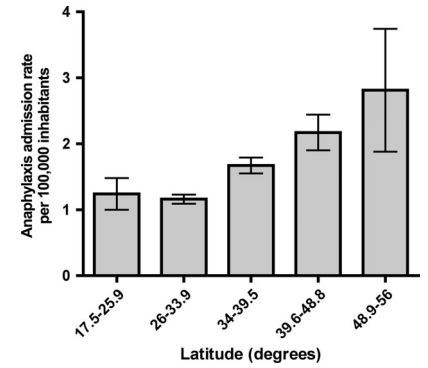Less sun (less vitamin D) more anaphylaxis (severe allergic reaction)
Higher latitude and lower solar radiation influence on anaphylaxis in Chilean children
Pediatric Allergy and Immunology, Volume 25, Issue 4, pages 338–343, June 2014, DOI: 10.1111/pai.12211
Rodrigo Hoyos-Bachiloglu1,2, Pamela S. Morales1, Jaime Cerda3, Eduardo Talesnik1, Gilberto González4, Carlos A. Camargo Jr5,6 andArturo Borzutzky1,2,*
Background
Recent studies suggest an association between higher latitude, a proxy of vitamin D (VD) status, and allergic diseases. Chile provides an ideal setting to study this association due to its latitude span and high rates of VD deficiency in southern regions. The aim of this study is to explore the associations of latitude and solar radiation with anaphylaxis admission rates.
Methods: We reviewed anaphylaxis admissions in Chile's hospital discharge database between 2001 and 2010 and investigated associations with latitude and solar radiation.
Results
2316 anaphylaxis admissions were registered. Median age of patients was 41 yr; 53% were female. National anaphylaxis admission rate was 1.41 per 100,000 persons per year. We observed a strong north–south increasing gradient of anaphylaxis admissions (β 0.04, p = 0.01), with increasing rates south of latitude 34°S.
A significant association was also observed between solar radiation and anaphylaxis admissions (β −0.11, p = 0.009).
Latitude was associated with food-induced (β 0.05, p = 0.02), but not drug-induced (β −0.002, p = 0.27), anaphylaxis.
The association between latitude and food-induced anaphylaxis was significant in children (β 0.01, p = 0.006), but not adults (β 0.003, p = 0.16). Anaphylaxis admissions were not associated with regional sociodemographic factors like poverty, rurality, educational level, ethnicity, or physician density.
Conclusions
Anaphylaxis admission rates in Chile are highest at higher latitudes and lower solar radiation, used as proxies of VD status. The associations appear driven by food-induced anaphylaxis. Our data support a possible role of VD deficiency as an etiological factor in the high anaphylaxis admission rates found in southern Chile.
PDF is available free at Sci-Hub 10.1111/pai.12211

See also VitaminDWiki
11X more non-immigrant children allergic to peanuts if vitamin D less than 20 ng – Feb 2013
30 to 40 ng of vitamin D associated with the least peanut allergy – Nov 2012
3X more allergy to peanuts if child born with low UV – Feb 2011
Search VitaminDWiki for anaphylaxis 90 items as of April 2018
-
The items in Autoimmune and Infant-Child D are listed here:
{category}
